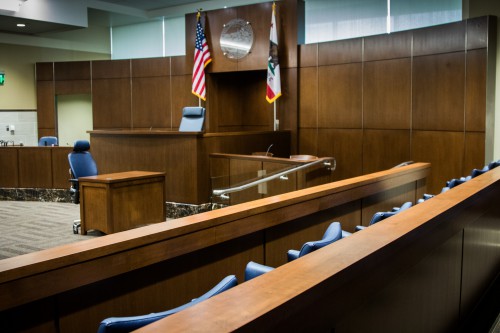 By Carla Arango and Samantha Brill
By Carla Arango and Samantha Brill
The trial of the People v. Darnell Dorsey resumed on October 18, 2016, with Dr. Kevin Coulter, professor and interim chair of the Department of Pediatrics at UC Davis Children’s Hospital, who testified that Cameron Morrison’s injuries were inflicted through significant force. Dr. Coulter specializes in pediatric child abuse and neglect.
Mr. Dorsey is charged with Cal. Penal Code sections 273a and 273ab, assault on a child resulting in death, after Cameron Morrison, Mr. Dorsey’s step-child who was under his care, was pronounced dead on January 25, 2014, at the age of nearly 20 months.
Dr. Coulter completed his residency at the Children’s Hospital in San Francisco in 1980 and a fellowship at the San Francisco General Hospital in 1982. Dr. Coulter reviewed Cameron Morrison’s medical records and treated the child when he arrived at the UC Davis Medical Center intensive care unit on January 23, 2014.
During direct examination, Deputy District Attorney Michelle Serafin asked about the frequency of abusive head trauma (also called shaken baby syndrome) cases during his time at San Francisco General Hospital. Dr. Coulter said it wasn’t uncommon for him to encounter those type of cases.
Dr. Coulter said he makes findings or has strong suspicions of child abuse in less than 50 percent of the cases he works on. He diagnosed Cameron Morrison with abusive head trauma, an injury to the brain that’s inflicted through abuse.
According to Dr. Coulter, scalp bruising, skull fractures, injuries to the brain, bruising on certain parts of the body – such as the chest or face, fractured ribs, arms or legs, and abdominal visceral injuries – are all associated with abusive head trauma. At the time of death, doctors noted Cameron Morrison had fractured ribs, hemorrhaging of the optic nerve and brain, and liver lacerations.
Ms. Serafin asked Dr. Coulter if he relied on other pediatricians to evaluate patients or if he diagnoses patients on his own. Dr. Coulter said it was very important for him to get his colleagues’ input.
Dr. Coulter testified that he usually follows the same routine when he’s asked to consult on a case. He explained that the first thing he does is to look at the patient’s medical record, and then he speaks to the parents or guardians in order to find out more information about the patient’s medical history and get a sense of what happened. Then, he meets with the radiologist and goes over any X-rays or CT scans. He examines the child and continues to seek out information and consult with other doctors.
Dr. Coulter confirmed that he reviewed Cameron’s medical history, he reviewed images of Cameron Morrison’s test results with the radiologist, and he reviewed radiology images from UC Davis Medical Center with neurologist Dr. Paul Lee, and pediatric radiologist Dr. Chirag Patel.
“It’s very important to hear their interpretation of what the findings are and determine what would be the next steps that need to be taken,” Dr. Coulter said.
In addition, he reviewed CT scans taken at Sutter Davis Hospital and UC Davis Medical Center.
Ms. Serafin asked if he noticed any differences between the images from the two hospitals. Dr. Coulter he noticed the amount of edema had worsened in between the two images, meaning that the brain swelling had increased after the first image from the Davis hospital.
When asked how much time had passed between images, Dr. Coulter said he didn’t recall exactly but it had been about a day.
Dr. Coulter said that the fact that the brain edema was getting worse posed medical problems for Cameron.
Ms. Serafin then proceeded to ask about Cameron’s heartbeat. Dr. Coulter replied that Cameron’s heartbeat was very low.
“They had a recorded heartbeat that was very low. I think it was 24 beats per minute,” Dr. Coulter said.
Ms. Serafin asked Dr. Coulter to explain when cardiac arrest can happen in children. Dr. Coulter said a primary cardiac arrest could occur as a result of heart disease or electrical abnormalities, and the fact the child was not breathing made it a secondary cardiac arrest.
When Dr. Coulter reviewed radiologic images he found bleeding toward the center or front of the skull, rib fractures, and liver lacerations. Mr. Serafin asked if he was concerned about child abuse after reviewing records from Sutter Davis Hospital. Dr. Coulter said he was.
“Rib injuries are uncommon accidental injuries in children. Ribs are flexible, they don’t just break by just playing, in a healthy child,” Dr. Coulter said.
Ms. Serafin then asked if CT scans at both hospitals confirmed Cameron had rib fractures at various stages of healing. Dr. Coulter said they did.
Dr. Coulter said he evaluated Cameron for other diseases that would cause bone fragility. Cameron was tested for osteogenesis imperfecta, which is characterized by fragile bones that break easily, Menkes disease (MNK), a genetic disorder which affects copper levels, and rickets disease, a weakening of bones as a result of vitamin D deficiency. Dr. Coulter concluded Cameron did not have osteogenesis imperfecta or rickets.
Ms. Serafin asked about the possibility that the CPR which was administered resulted in rib fractures.
“I personally haven’t had an experience of rib fractures from CPR,” Dr. Coulter said.
Dr. Coulter confirmed that there have been reports of children who get CPR and then show rib fractures in the X-rays.
Dr. Coulter said that the fact that there were many healing and healed rib fractures, suggested that they were not caused by CPR.
“The healing obviously started before the CPR occurred,” Dr. Coulter said.
Dr. Coulter said that, besides suffering an accident in September of 2013, concerns of a respiratory illness early in his first year, and a short ear infection, Cameron Morrison had been healthy up until a few days prior to the night he was taken to the hospital.
Ms. Serafin asked Dr. Coulter if a child could experience severe pneumonia leading to respiratory arrest, then causing cardiac arrest. Dr. Coulter said it could happen.
Ms. Serafin then asked Dr. Coulter if a child who suffers a respiratory arrest or cardiac arrest would be weak or lethargic. Dr. Coulter said yes.
Ms. Serafin asked if he would expect a child to be playing, eating, or watching TV normally one hour before experiencing a respiratory arrest. Dr. Coulter said no.
Dr. Coulter also examined Cameron’s eyes. He said Cameron’s pupils didn’t respond to light, which suggested a significant injury to the brain, because it’s a reflex reaction that should occur normally. Dr. Coulter observed hemorrhaging in the retinas of his eyes, which is common in children who have had head injury.
Dr. Coulter stated he observed subdural hematoma (a pool of blood between the brain and its outermost covering) in Cameron’s CT scans. Traumatic, accidental, and abusive head injuries, as well as pre-existing bleeding disorders, are common causes of subdural hematoma.
Cameron was seen by an ophthalmologist, pediatric surgeon and neurosurgeon. His labs were evaluated by a pediatric hematologist and he was treated by ICU staff. Radiologic images were examined by a pediatric radiologist, and a nuclear scan was taken to look at blood flow.
After reviewing the medical records and speaking to the parents, Dr. Coulter said he was concerned that Cameron’s injuries were due to child abuse.
“We did not find any other cause,” Dr. Coulter said.
Ms. Serafin asked under what circumstances would he be able to see all those injuries present at the same time. Dr. Coulter said they could happen during major motor vehicle accidents, with the exception of healing rib fractures, or in an event where multiple trauma is going on.
“I believe they were inflicted,” Dr. Coulter said, regarding Cameron’s injuries.
Lastly, Ms. Serafin asked Dr. Coulter if there was evidence to believe that pneumonia led to respiratory arrest which then caused a cardiac arrest, resulting in Cameron’s brain injuries.
“I don’t believe this child had a respiratory arrest from pneumonia,” Dr. Coulter said.
Deputy Public Defender Martha Sequeira began cross-examination by asking Dr. Coulter about confirmation bias, which she defined as a tendency to search for facts that favor a hypothesis in place.
She established and Dr. Coulter confirmed that often times doctors must quickly make important decisions without having all the information available. She also asked if doctors are aware that sometimes their decision might not be the correct one, and Dr. Coulter agreed.
She asked Dr. Coulter about how he teaches confirmation bias. He said he teaches his students to consider options and the importance of a differential diagnosis.
Ms. Sequeira suggested that, because he is effectively the boss in his department, there are residents who may be afraid to disagree with him.
Dr. Coulter said he agrees with the fact that often people are afraid of their boss, but said he doesn’t think that applies to him.
Ms. Sequeira asked how we would know that, and the doctor said he knows because residents tell him when they disagree with him.
The People’s Witness Dr. Kevin Coulter Continues His Testimony
By Samantha Brill
The afternoon of October 18, 2016, brought the resumption of the case of the People v. Darnell Dorsey, Judge Paul Richardson presiding. Pursuant to Cal. Penal Code sections 273a and 273ab, Mr. Dorsey is being charged with assaulting and causing fatal injury to his girlfriend’s 20-month-old child, Cameron Morrison, in January of 2014. Deputy Public Defenders Martha Sequeira and Joseph Gocke represent Darnell Dorsey, while Deputy District Attorney Michelle Serafin represents the People.
Dr. Kevin Coulter continued with his testimony as Ms. Sequeira began the line of questioning for the defense’s redirect examination. While inquiring about how and why a medical doctor conducts research, she asked what would motivate a doctor to research a particular topic. Dr. Coulter explained that it is usually part of the requirement of the doctor’s position and that they tend to be interested or have some background knowledge on the topic chosen to research.
Dr. Coulter continued to explain that medicine is not an exact science and that results of studies done are shared and are expected to be read so doctors can stay current in their practice. In addition is the fact that, when one has done more research in a particular field, their opinions tend to be more respected.
In his day to day practice he explained that, because of his past experience with child abuse cases at San Francisco General Hospital in the 80’s, he tends to be one of the go-to guys at UCD Medical Center in such cases. However, he does often get second opinions, because the exercise of getting second opinions is common practice throughout that medical field.
Mrs. Sequeira then moved into more detailed questions about his explicit experience with child abuse cases. Dr. Coulter explained that the three main types of child abuse cases that he sees are sexual, physiological, and physical. However, he did not recall exactly how many he has seen of each. And because of a change in Sacramento County funding involving child abuse cases, UCD Med Center was no longer funded by the county so he has not seen a sexual child abuse case since 2006.
The defense then moved on to ask more specific questions about Cameron. Dr. Coulter told the court that he only talked to Cameron’s mother about Cameron’s medical history. He said he took this history of birth marks, eczema, and other things into consideration when diagnosing Cameron.
He also mentioned that he did ask the mother about the bruising Cameron had on his ear lobe, and she stated it had been there for two weeks. This brought up suspicion because bruising on the ear lobe is hard to get and is not common.
Dr. Coulter went on to explain the exam that he gave Cameron, and explained that his nose, neck, and chest looked okay. At the time of this first exam Cameron had been on a ventilator to help him breathe.
Regarding the ventilator, Dr. Coulter explained that the tube of the ventilator inside Cameron’s airway had not been changed during Cameron’s stay, simply because Cameron wasn’t at the hospital long enough. Furthermore, because Cameron’s stay was so short it was unlikely that an infection from the ventilator tube had caused Cameron to contract a pneumonia, that the pneumonia most likely was already there.
Mrs. Sequeira then started asking Dr. Coulter about Cameron’s brain death diagnosis. She asked him if the swelling in Cameron’s brain had increased at all from his time at Sutter Davis Hospital to UCD Med Center. Dr. Coulter responded by saying it had increased rapidly and he could tell, not only from the CT scans that a radiologist helped him interpret, but also from the non-responsiveness from Cameron’s pupils.
Moving on, the next line of questioning from the defense was regarding the testimony Cameron’s grandmother had made regarding Cameron projectile vomiting the afternoon before the incident. Dr. Coulter said that a symptom like that could be because of the flu, however, Cameron had tested negative for flu, so pneumonia could have been the cause of the projectile vomiting. With that the defense rested.
The People then began recross examination of the witness, asking if Cameron’s older brother had similar symptoms, whether it was likely that Cameron had the same virus. Dr. Coulter responded by saying that yes, this was very likely, and that both their symptoms were consistent with that of a viral infection.
Dr. Coulter further explained that no one had noted that Cameron showed signs of pneumonia on the CT scans. All that had been noted was that there was a contusion on the lung – that could have caused pneumonia, but pneumonia could not have caused the contusion.
The People then went back to questioning about the ventilator, where the witness explained that, during the first day in the hospital, Cameron did take some of his own breaths, while getting assistance breathing.
Then, returning to Dr. Coulter’s examination of Cameron, he explained that he read over police reports involving this case during his time with Cameron. Also, his professional opinion was that, if Cameron’s injuries had happened earlier in the day, the child would not have been able to eat and play with other kids by 10pm at night. Dr. Coulter finished by saying that, in his independent opinion, Cameron did suffer from child abuse. The People rested.
Mrs. Sequeira conducted a final recross for the defense, clarifying that the breathing Cameron was doing on the ventilator was only a reflex that his body was making. The point was that, in the ambulance ride, if measures had not been taken to help Cameron breathe, the child would not have made it to the hospital alive.
The defense ended the afternoon by clarifying with the witness that, because medicine is not an exact science, many of the answers Dr. Coulter made in the courtroom consisted of “maybe” and “probably.” Dr. Coulter agreed, and then the court dismissed him and the afternoon session ended.




